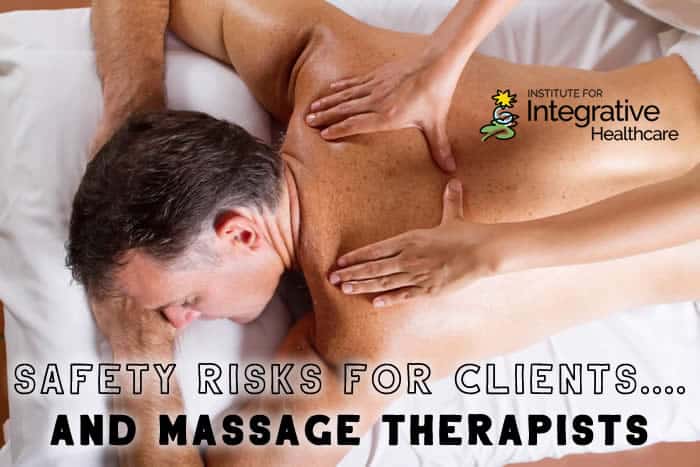

The massage profession tends to attract people who are concerned with the well being of others.
And much of our training is focused on ensuring the client’s safety during treatment:
- learning contraindications
- how to stretch clients without harming them
- which clients need specialized types of massage
- and so on.
But the therapist’s safety must also be guarded. What, though, constitutes a risk to that safety? And how should such situations be handled?
Risks to Therapists’ Safety
Some situations might be unambiguously threatening—for example, if a client were wielding a weapon or physically restraining the therapist—but not all scenarios are so clear-cut. The prevailing advice regarding this issue seems to be trust your gut (1, 2, 3).
Several therapists recommend using a phone conversation to screen clients who call to book an appointment (3, 4, 5). Having a list of screening questions (see, e.g., 3) can help you identify in advance clients who might pose a danger.
Red flags include:
- refusal to give a full name or other screening information
- a request to be seen immediately
- and expressions of anger (3, 4).
“If a caller refers to his or her emotional state in an emphatic tone of voice, complains about other MTs, or references dramatic life changes, you may want to be on the lookout for significant underlying issues that would be better addressed by a mental health therapist” (3).
During the short time I advertised for clients to come for massages at my in-home massage studio, I hadn’t developed a standard list of questions for potential clients. But the phone conversation I had with the first person to contact me through Yelp proved the value of prescreening. The caller, a man, asked me a few questions about the massage and then asked if there was a shower he could use after the massage. Shower facilities aren’t that unusual for a large-scale spa, but I explained to the man that as the massage room was in my house, no shower was available to clients. I assured him, though, that I didn’t use excessive amounts of oil. But he persisted in asking if he could use the shower. I got a creepy feeling about his insistence on showering following the massage and so suggested that perhaps he should seek a different massage therapist. Right after that, I pulled my ad for massage service from Yelp.
Echoing this point about prescreening clients by phone, Terri Visovatti of Urban Wellness Chicago said that over the years she has received “a small handful of weird calls/emails but really most nipped in bud where if they were going to become something they didn’t.”
But even the best screening process won’t reveal every potentially problematic client.
- What do you do if you are already in the massage room when you begin to feel unsafe with a client?
- And how do you assess whether the client is actually a threat?
Both of these questions are somewhat situational.
Cherie Sohnen-Moe differentiates between a boundary crossing and a boundary violation. “A boundary crossing is a transgression that may or may not be experienced as harmful” (6), whereas a boundary violation is a transgression of a boundary that is indeed harmful. But even this assessment is contextual. For instance, if a male client gets an erection during a massage, this isn’t necessarily an indication that he has sexual misconduct in mind. An erection can be a physiological response to touch, any kind of touch, and may happen “even when [men] are not necessarily emotionally desirous of sex” (6).
If the erection happens in the context of intensifying inappropriate behaviors (e.g., the client “accidentally” undraping himself repeatedly) and/or comments (e.g., telling sexually explicit jokes)—or even if such boundary crossings escalate without a physiological manifestation from the client—the actions or comments should not be ignored.
The first thing to do if you feel a client has crossed the line is to break physical contact. If the client’s behavior feels intimidating, don’t stand close to the table and place yourself close to the door so that if the client actively threatens you, you can easily escape (6).
A friend of mine is still haunted by an incident that happened more than a decade ago in which she felt the need to escape. She had, several times previously, been to this particular client’s home to do massage for him. Though he was divorced, there had always been, on previous visits, a woman in the home when my friend arrived to provide this Chicago police officer with a massage. On one occasion, however, the woman was not present in the home, and the man tried to persuade my friend to bring her table to the rear of the house to the basement; on prior visits, she had always done the massages in the living room. He was very insistent, but the therapist remained firm that they stick to their usual routine.
But after the massage had been completed and she had packed up her things, he grabbed her folded massage table from her and pushed her against the wall, then tried to push her with the table between them toward the rear of the home. She remembers kicking at the table, trying to get away. She finally was able to escape with her sheets and lotion but had to leave the table behind.
A couple of days later, she contacted a police officer friend of hers to get her advice about getting the table back. Her friend said she’d check around and see what she could find out about the officer who had threatened her. When her friend called back, she told her this officer was bad news; it would be best if she chalked up the table as a loss and leave it alone. That was the last time she ever did a massage at a client’s home.
In contrast, when I was working at a fitness club, I had a client who came in for a special promotional event created by the manager of the spa. As soon as I reentered the room after giving him time to get on the table, he began complaining it was too hot and asked if he could take off the sheet. I told him he had to remain draped, but I could put a fan on to circulate the air better. He said that would be too noisy. He asked again about taking off the sheet. I told him that was against state law and that he had to remain draped. I offered to end the session and not charge him for the massage, but he stayed. I was definitely uncomfortable, but since he never got aggressive or physical with me, and since I was in a large club with lots of people just outside the massage room door, I wasn’t especially afraid for my safety. Had I been in a more private setting, I might have felt differently. As it was, I was merely creeped out.
Similarly, a therapist I know who was working in a salon setting with others just beyond the door had a client grab her breast during the massage while turning over. “I was in shock, it happened fast and I didn’t want to believe it initially, but upon reflection I was sure it was no accident. There was a certain amount of shame on my part [because] he wasn’t a new client that was trying to be inappropriate, he was someone I thought I had a rapport with and respected.” It was her last day doing massage at this salon in an upscale suburb, so she ended up doing nothing about the client’s boundary crossing, but the incident made a lasting impact on her: “My faith in people was a little shaken.”
As a final illustration of how difficult it can be to gauge when a situation warrants concern, when I was doing outcalls to hotels, the client greeted me at the door of his room wearing nothing but a towel around his waist. I entered the room, though not without reservations. The man, however, never made either any physical advances toward me or any sexually charged comments, and I gave the massage without any incident. I would likely have been at ease from the start, however, if I had known about one therapist’s recommendation to check in with the hotel desk from the phone in the client’s room, telling him or her that this is hotel policy (1).
This kind of ambiguity, though, is a definite source of anxiety for therapists. At the root of this ambiguity is, at least in part, the long association between massage and the sex trade (7). While massage has definitely made tremendous progress, even in the last decade or two, in demonstrating that it has value as an important therapeutic tool, the threat of sexual harassment remains. The very nature of the work, which is fundamentally intimate, can facilitate confusion about intentions on both the part of the therapist and that of the client. A clear statement during the intake process about the nonsexual nature of the massage can help avoid inappropriate requests during the massage (5).
Of course, sexual misconduct is not the only safety issue confronting massage therapists.
A client with a contagious disease or illness, for instance, or one asking for a level of pressure or a technique that would be injurious to the therapist would also create potential safety issues. Such situations, however, are less ambiguous than those described above—though a client intent on getting what he or she wants regardless of its potential harm to the therapist could become verbally or physically abusive.
In any situations of potential danger, if you are working alone in an isolated area, it’s not a bad idea to install a security system if it’s your own work space or to keep on hand something like pepper spray (1).
And if you are in any kind of threatening situation, don’t rule out simply leaving, even if it means leaving your things behind; the police can help you retrieve those later (1).
Risks to Clients’ Safety
There are, of course, also known risks to clients’ safety—contraindications that would preclude massage or at least massage locally for clients with particular conditions or diseases. But there may also be instances that are less definitive or where the massage must be terminated partway through for the client’s own safety.
I recall having a client at the fitness club who was so morbidly obese that I needed to stack up multiple face cradles before his belly height above the table would allow his face to rest comfortably. I had serious doubts about whether the table would hold him but was too timid to ask his weight and compare it with what the table was designed to hold. The table held up, but in retrospect, I clearly should have set aside my own shyness in the name of keeping the client safe from harm.
In another situation, I put the safety of my client’s ahead of all else. When I was working at the fitness club, I got shingles. I knew that it was possible for my shingles to cause chickenpox in someone who had never had it or never had the vaccine. Pregnant women, I knew, were particularly vulnerable, and I worried about contact with a woman who was perhaps pregnant but didn’t yet know it. So I stayed home from work for a few days. Though I thought at the time I was doing the right thing, it turned out that my manager felt differently, and my decision to skip work during that time was noted negatively in my annual review. Nevertheless, I feel confidant I did the right thing.
This brings up another issue, though: when you are not your own boss, you may be put in the terrible position of having to decide between what your boss demands of you and what you know to be ethically correct. I knew of a woman who, fresh out of massage school, was told by her employer not to change the sheet on the table after every client but, instead, to turn it inside out. She knew this was unsanitary and could potentially spread illness or disease, but she was uneasy about going against her supervisor’s wishes. Your conscience will need to be your guide in situations like these as you weigh your needs against the safety of the client.
In Summary
The therapeutic relationship is fraught with potential threats to its maintenance. Sometimes a client and therapist are just not a right fit for each other, and though it can be painful to lose a client you don’t click with, much more pressing are situations where you fear for your own or your client’s well being. No one wants to think about negative situations, but the more prepared you are to deal with such eventualities (1, 3, 4, 5), the better the outcome will be.













